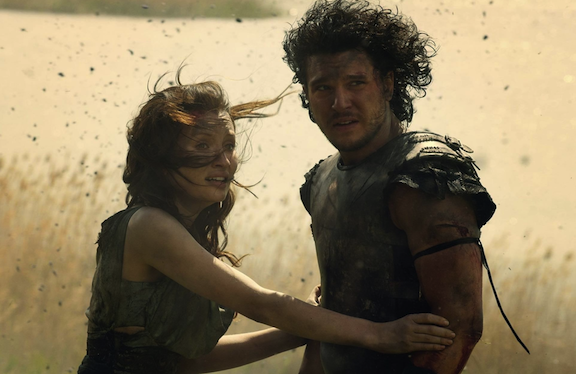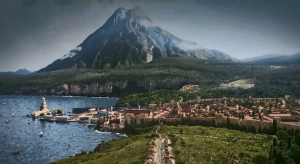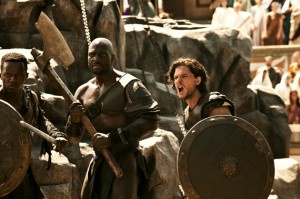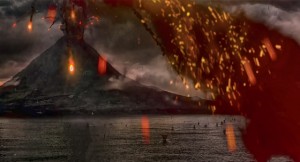Image may be NSFW.
Clik here to view.
Back in the 19th century when I was writing for a print weekly, I frequently found myself on the No Press Screening movie beat. What that meant was that I’d cover the movies that weren’t shown to critics in time to be reviewed by print deadline, movies effectively hidden from the press until opening day. This was the Tyler Perry beat, the Adam Sandler beat, the Underworld beat… and the Paul W.S. Anderson beat. When Anderson’s The Three Musketeers (2011) and Resident Evil: Retribution (2012) opened, it fell on me to see the midnight screening or the matinee on Friday, and then immediately turn over an online-exclusive blurb review.
While these movies were being unceremoniously snuck into theaters through the back door, something funny happened. Paul W.S. Anderson—who I will refer to as P.W.S.A. from here on—suddenly acquired a splurt of critical cachet among a small gang of cinephile perverts, a lowering of standards of which I am delighted to have done my small part. Now even the usually somnolescent studio flacks seem to have taken note: Pompeii, which is being released wide today in the US by TriStar Pictures, is the first P.W.S.A. movie that I can recall that’s had a proper advance press screening. He’s coming through the front door now.
Accordingly, there has been a backlash gathering among the dozen or so people who are still willing to polemicize about film aesthetics. We hate it when our genre filmmakers become successful. (And if they’re Northern, it’s even worse.) The gist of most of the complaints that I’ve seen about the P.W.S.A. mini-cult—and I freely admit I have not done deep research into the matter—is that the whole thing smacks of trying too hard. This is a peculiar charge, for if there’s one thing that you don’t have to do while watching a P.W.S.A. movie, it’s strain yourself: Their pleasures are abundantly self-evident, and they couldn’t be any easier to enjoy if they gave you a lap dance. Nevertheless, the trailer for Pompeii fetched its share of anticipatory giggles, much like the giggles that the smart set might have greeted previews for Fritz Lang’s Indian Epic with. Not that I’m comparing P.W.S.A. to Lang—I leave that to Anderson’s most eloquent admirer, Dave Kehr.
Pompeii opens with an epigraph taken from Pliny the Younger’s letters to the historian Tacitus, the most famous account of the eruption of 79 A.D. that killed uncle Pliny the Elder, among thousands of others, and lay a smothering blanket of volcanic debris over the Roman cities of Pompeii, Herculaneum, and Stabiae (sequel opportunites!). The passage excerpted—“You could hear women moaning, children howling, and men shouting,” etc.—actually refers to the scene in Misenum, across the Gulf of Naples, where the Younger was situated, but who’s really here for history lessons?
Image may be NSFW.
Clik here to view. The text is followed by two heaps of bodies: the first are the famous sculptural dead of Pompeii, to whom we will return in time; the second are a clan of barbarians whom a Roman legion has put to the sword. We arrive in “Northern Britannia” in A.D. 62 in time to catch the end of Rebellion of the Celtic Horse Tribes, which would be a pretty fair name for an instrumental track on your metal album. After the slaughter, only one boy, Milo, is left alive, carrying within him the image of the Roman invaders who murdered his parents (Kiefer Sutherland and Sasha Roiz.) The ghastly image of a lone, bare-limbed tree decorated with the dead is enough to make one wonder what P.W.S.A. could’ve done with the Conan the Barbarian property, which was so horribly botched by Marcus Nispel.
The text is followed by two heaps of bodies: the first are the famous sculptural dead of Pompeii, to whom we will return in time; the second are a clan of barbarians whom a Roman legion has put to the sword. We arrive in “Northern Britannia” in A.D. 62 in time to catch the end of Rebellion of the Celtic Horse Tribes, which would be a pretty fair name for an instrumental track on your metal album. After the slaughter, only one boy, Milo, is left alive, carrying within him the image of the Roman invaders who murdered his parents (Kiefer Sutherland and Sasha Roiz.) The ghastly image of a lone, bare-limbed tree decorated with the dead is enough to make one wonder what P.W.S.A. could’ve done with the Conan the Barbarian property, which was so horribly botched by Marcus Nispel.
Captured by the Romans, Milo is sold into slavery and the arena, and as a grown-up gladiator nicknamed “The Celt” has become Kit Harington from Game of Thrones, a well-molded, handsome little fellow. (“That’s what you came to see, right?” the guy in front of me said to his date when Harington first appeared on screen, six-pack artfully touched up with grime. This struck me as an odd comment.) Having dispatched all the available Thracians in the miserable, mucky provincial capital of Londinium, Milo’s next stop is a certain resort town in the shadow of Vesuvius, where he arrives just in time to participate in the games marking the Festival of the Vinalia.
Along the road to Pompeii, Milo encounters the retinue of Cassia (Emily Browning), a highborn Pompeian returning home from a season in Rome. They catch each other’s eye, and hereafter they’ll share the narrative, with Cassia yearning for morganatic romance from her proverbial gilded cage high in the hills, and Milo training for certain death in a literal cage. (One deft transition cuts from disobedient Milo taking punitive lashes to distraught Cassia having her hair brushed.) Milo is bunked up with the undefeated champion of the Pompeian arena, Atticus, who’s played by Adewale Akinnuoye-Agbaje, the Anglo-Nigerian actor probably best recognized from HBO’s Oz, quietly dominating every scene he’s in with an imperious smirk. Where P.W.S.A. opened his last film, Resident Evil: Retribution, with a cannonade of voluptuous slo-mo fanfare, Pompeii is a more deliberately plotted affair, in part I suppose because the very subject matter affords a more deliberate build up. The movie is called Pompeii—there will be magma!
Image may be NSFW.
Clik here to view. But first, some blood to whet the appetite. While shut up in the gladiator’s quarters, where shivs are wielded and scores settled, Pompeii most resembles Anderson’s prison picture, Death Race (His last outing without wife and muse Milla Jovovich.) If P.W.S.A. has one single identifiable signature, it’s that he likes to delimit and clearly map out the spaces in which his films take place: this goes for the penitentiary/ track in Death Race, Event Horizon’s space station, the pyramidic hunting ground of Alien vs. Predator, and the gameboard Europe made of precious marble inlaid in the floor of Cardinal Richelieu’s chambers The Three Musketeers. Perhaps this can be traced back to the director’s work in video game adaptations—think of these as cutaways to the map screen or overworld—but it’s also good, spatially-coherent filmmaking. When P.T. Anderson’s The Master and P.W.S.A.’s Resident Evil: Retribution were released head to head in 2012, many writers, myself included, couldn’t resist the bait, thought the more instructive comparison might be to another world-building Anderson, Wes. The difference being that P.W.S.A.’s Grand Budapest Hotel would almost certainly self-destruct at the end with most of the cast inside.
But first, some blood to whet the appetite. While shut up in the gladiator’s quarters, where shivs are wielded and scores settled, Pompeii most resembles Anderson’s prison picture, Death Race (His last outing without wife and muse Milla Jovovich.) If P.W.S.A. has one single identifiable signature, it’s that he likes to delimit and clearly map out the spaces in which his films take place: this goes for the penitentiary/ track in Death Race, Event Horizon’s space station, the pyramidic hunting ground of Alien vs. Predator, and the gameboard Europe made of precious marble inlaid in the floor of Cardinal Richelieu’s chambers The Three Musketeers. Perhaps this can be traced back to the director’s work in video game adaptations—think of these as cutaways to the map screen or overworld—but it’s also good, spatially-coherent filmmaking. When P.T. Anderson’s The Master and P.W.S.A.’s Resident Evil: Retribution were released head to head in 2012, many writers, myself included, couldn’t resist the bait, thought the more instructive comparison might be to another world-building Anderson, Wes. The difference being that P.W.S.A.’s Grand Budapest Hotel would almost certainly self-destruct at the end with most of the cast inside.
P.W.S.A. has all of Pompeii to play with here, and long before the eruption, he’s discreetly shown us the lay of the city and its environs from the deck of Cassia’s family villa. We know exactly where that villa is, where the army encampment, the city, and the harbor are, where all of them stand in relation to one another and to Vesuvius. There’s a scene in which Cassia’s well-meaning but ineffectual father, Lucretius (Jared Harris), tries to interest a visiting Roman dignitary in investing Imperial money into Pompeii, where he leads the Roman into a room full of scrupulous scale models. This must be what one of P.W.S.A.’s pre-production meetings is like–except of course he’s planning to raze, not build.
It’s a small Empire after all: That distinguished Roman visitor is none other than the butcher of Milo’s family, now Senator Corvis, wearing the Imperial purple and trying to bully a promise of marriage out of Cassia—until he discovers that he has competition in the form of Milo. The comparisons to fellow historical catastrophe romance Titanic are inescapable here, with Milo and Cassia as Jack and Rose, and Sutherland, playing Corvis, given full license to ham up the Billy Zane part, adopting a curious cotton-in-the-cheeks accent for good measure. Corvis’s solution to his romantic conundrum is to turn the games that he’s presiding over into a sure slaughter, staging them as a dramatic re-enactment of his great victory over the Celtic tribes. As a chorus delivers a print-the-legend account of events, Milo, Atticus, and a handful of their fellows are chained by the ankle to a monumental simulated rockpile in the middle of the arena, where they are surrounded by a Roman legion-emulating battalion, better armed and outnumbering them three-to-one.
Image may be NSFW.
Clik here to view. After a nice preliminary undercard, this is Pompeii’s first big bout, and it’s a doozy. P.W.S.A. uses a plenitude of set-ups from mobile and fixed positions, and shoots acres of coverage, but all that footage isn’t destined to be pulped into a mash of indistinguishable motion in the editing room, the too-common hurly-burly that’s meant to disguise the fact that there was no scene there in the first place. While skipping around the action to break it into glimmering facets, P.W.S.A.’s keeps motion flowing fluidly, rhythmically, with both combatants and key spectators, action and reaction, ever before the viewer. He shoots swordplay at the speed of thought, making you privy to the split-second, life-or-death process of assessment, analysis, and response. P.W.S.A.’s set pieces are elegant illustrations of grace under pressure, and while he may have aligned himself with the barbarians here, the hard, Roman clarity with which he shoots marks him as something of a Classicist. Renny Harlin, responsible for this year’s perfunctory The Legend of Hercules, should look upon P.W.S.A.’s agility in the arena and despair.
After a nice preliminary undercard, this is Pompeii’s first big bout, and it’s a doozy. P.W.S.A. uses a plenitude of set-ups from mobile and fixed positions, and shoots acres of coverage, but all that footage isn’t destined to be pulped into a mash of indistinguishable motion in the editing room, the too-common hurly-burly that’s meant to disguise the fact that there was no scene there in the first place. While skipping around the action to break it into glimmering facets, P.W.S.A.’s keeps motion flowing fluidly, rhythmically, with both combatants and key spectators, action and reaction, ever before the viewer. He shoots swordplay at the speed of thought, making you privy to the split-second, life-or-death process of assessment, analysis, and response. P.W.S.A.’s set pieces are elegant illustrations of grace under pressure, and while he may have aligned himself with the barbarians here, the hard, Roman clarity with which he shoots marks him as something of a Classicist. Renny Harlin, responsible for this year’s perfunctory The Legend of Hercules, should look upon P.W.S.A.’s agility in the arena and despair.
How do you top this? That’s Vesuvius’s cue. Here Pliny the Younger again, with a description of the eruption:
“The pine tree, rather than any other, best describes its appearance and shape, for it rose high up into the sky on what one can describe as a very long trunk, and it then spread out into what looked like branches… Its appearance varied between white on the one hand, and grimy and spotted on the other, according as it had thrust up earth or ashes.”
To this Pompeii adds catapulting fireballs hurtled far enough to tag fleeing ships at sea, hunks of cinder and pumice stone raining from the sky to knock panicked citizens insensate, massive fissures opening up in the earth to swallow puny humans whole, and a tidal wave in the Gulf that seals off any remaining hope of nautical escape. What was in fact two days of eruptions is telescoped into a single fraught day, but most of this grandiose carnage is accurate enough according to scientific conjecture and historical record. The eruption is beautiful and terrible, a billow of brimstone that’s like a stereoscopic John Martin canvas, the 3D keeping a flittering veil of snowy ash shimmering in front of the action. There isn’t a great deal to intellectualize here. Erupting volcanos are awesome, a fact of which I have been aware at least since seeing Ring of Fire in IMAX on a 6th grade class field trip. This one, which spews molten lava into your lap, is particularly awesome.
Image may be NSFW.
Clik here to view. There will a brief lull in the destruction and a momentary cloud-break, but any hope extended is false hope. Here is where, if you are honestly concerned that I will spoil your prospective viewing of Pompeii by giving away its outcome, you should probably stop reading. (You should then use the time you’ve freed up to reassess your entire relationship with art, and ask why it is that your pleasure or interest is contingent on what’s-around-the-next-corner suspense that shouldn’t concern any grown-up.) Suffice to say that the movie’s poster isn’t kidding when it says “No Escape.” Everybody dies. The images that open the film and will also close it, those of the casts of Pompeian bodies whose contortions were captured for eternity at the moment of death, is central to the film. Death comes for everyone; the nearest you can come to immortality is to face it with panache. This is central to the “For those about to die, we salute you” gladiator code, and the grimly jocular discourse between Milo and Atticus, men whose only inalienable property is their death. (“When you die in the arena you die unconquered,” says one, “and you spit in the eye of Rome.”)
There will a brief lull in the destruction and a momentary cloud-break, but any hope extended is false hope. Here is where, if you are honestly concerned that I will spoil your prospective viewing of Pompeii by giving away its outcome, you should probably stop reading. (You should then use the time you’ve freed up to reassess your entire relationship with art, and ask why it is that your pleasure or interest is contingent on what’s-around-the-next-corner suspense that shouldn’t concern any grown-up.) Suffice to say that the movie’s poster isn’t kidding when it says “No Escape.” Everybody dies. The images that open the film and will also close it, those of the casts of Pompeian bodies whose contortions were captured for eternity at the moment of death, is central to the film. Death comes for everyone; the nearest you can come to immortality is to face it with panache. This is central to the “For those about to die, we salute you” gladiator code, and the grimly jocular discourse between Milo and Atticus, men whose only inalienable property is their death. (“When you die in the arena you die unconquered,” says one, “and you spit in the eye of Rome.”)
In Pompeii, getting caught in an onrushing wall of pyroclastic flow is like getting your portrait taken for all time. Corvis, naturally, reveals his true wormlike nature, and dies groveling. Cassia’s parents go with hands clasped, a tender example that Milo and Cassia will follow when, unlike Jack and Rose, they decide to stop running and to hold their ground together, going out with tongues tangled. (They reappear before the closing credits as a twined-together plaster cast, an audacious bit of kitsch that was greeted in the screening I attended with equal measures of jeering and applause.) It’s Atticus, however, who gets the best exit of all, facing the onrush of fatal ash and roaring “I die a free man!” while giving the gladiator salute—which happens to double as a Black Power fist.
Yes, the dialogue in P.W.S.A. movies is functional at best and wretched at worst, and Pompeii is no exception, though I did enjoy the use of “By Juno’s tit!” as an exclamation. But more than mere vulgar Latin, Pompeii is a movie of real insurgent kick. There’s no hope of selling anyone on P.W.S.A. or his latest film who’s convinced that the “popcorn flick” is the panem et circenses of our day—a comparison that the movie is happy to play with. How is the city of Pompeii going to attract Roman investment, one character fumes, “if we can’t stage a simple bloody spectacle?” With Pompeii, P.W.S.A. has proven once again that he can do significantly better than that. Here’s hoping he gets to march on Rome next, and burn the motherfucker down.
Image may be NSFW.
Clik here to view. Nick Pinkerton is a regular contributor to Sight & Sound magazine and sundry other publications. He lives in Brooklyn, NY. Follow Nick on Twitter @NickPinkerton.
Nick Pinkerton is a regular contributor to Sight & Sound magazine and sundry other publications. He lives in Brooklyn, NY. Follow Nick on Twitter @NickPinkerton.